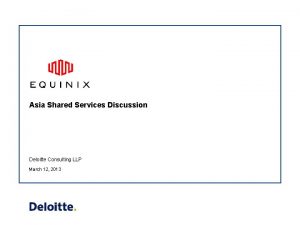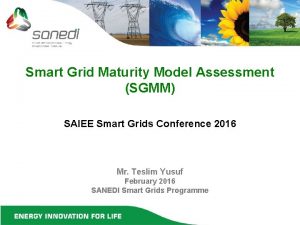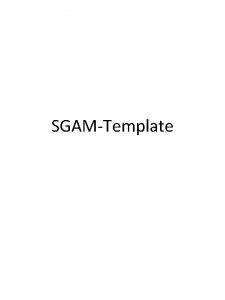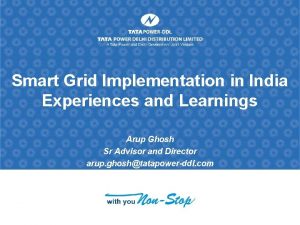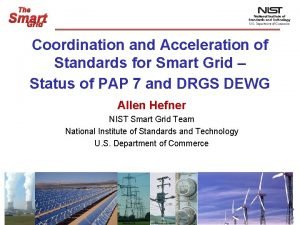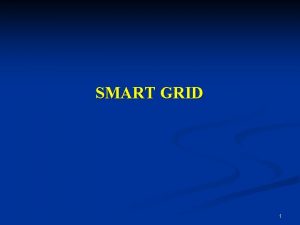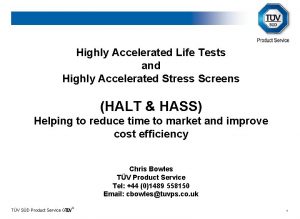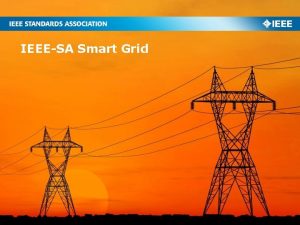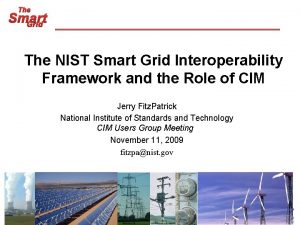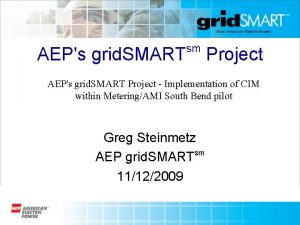SAIEE Smart Grid Conference 2016 Accelerated Environmental Stress















- Slides: 15

SAIEE Smart Grid Conference 2016: “Accelerated Environmental Stress Testing (AEST) for Smart Electricity Meters” By Shawn Papi Eskom Research, Testing & Development 23 February 2016

BACKGROUND • Smart meters are a fairly new technology, there is little understanding of their long term performance • Premature/unprecedented failure will have dire impact on business processes that rely on smart meter data • Meter replacement costs exceed price of meter, includes labour, storage, re-testing, etc. SMART METER AMI HEAD END SYSTEM

BACKGROUND • Unreliable smart will compromise customer safety, tarnish utility reputation • In this context AEST (“Eskom ALT”) becomes invaluable, as it provides insight into failure modes and associated risk prior to mass deployment

WHAT PREPAYMENT METERING HAS TAUGHT US…THE ”Electricity For All” PROGRAM • Meter reliability was key factor given the scale of the rollout, over 1 million meters at a rate of 300 000 per annum! • The technology was still in its infancy, Eskom had no knowledge of long term performance • While the meters conformed to SABS and IEC standards, they exhibited unacceptable failure rates in the field! • This drove the development of AEST for prepayment meters, providing a means for detecting design errors, low quality components and inadequate manufacturing processes • After a number of AESTs, the reliability of prepayment meters improved, substantially, Eskom now has over 4 million of these meters installed • South Africa is now a global leader in prepayment metering technology

OVERVIEW OF THE AEST PROCEDURE • Meters are designed to operate reliably for lengthy periods (10 -15 years), making long term performance testing under normal conditions impractical • AEST shortens the testing time required to stimulate the occurrence of failure modes the meter would experience under normal field conditions (It is a form of overstress acceleration) • Contra to traditional accelerated life testing methods, AEST involves multiple stress application

OVERVIEW OF THE AEST PROCEDURE A complete AEST comprises of the following: • Sampling: A batch of meters is randomly sampled from production lines or meter depot • Pre-Qualifying Test: The test batch (meters) undergoes detailed visual inspection • Vibration/ Drop Test: The test batch is subjected to random vibration testing and a subset of the batch undergoes a number of drop tests • Post-Vibration/Drop Test: This test is the same as Pre-Qualification Test and assesses the condition of the test batch post vibration and drop testing. • Stress Test: The meters are installed inside an environmental test chamber where they are subjected to three temperature/humidity cycles per day for a predetermined duration, typically 76 days for 24 -meter sample with a targeted cumulative test time of 10 years. While undergoing temperature/humidity cycle the meters are energised and “loaded” according to the voltage/current profile. In-between the temperature/humidity cycles the meters are removed from the chamber and subjected to additional stresses, and thereafter returned to the chamber for the continuation of the cycling. • Post Stress Test: Same as Pre-Qualifying Test

OVERVIEW OF THE AEST PROCEDURE – TEST SETUP

OVERVIEW OF THE AEST PROCEDURE – TEMPERATURE/HUMIDITY CYCLING

OVERVIEW OF THE AEST PROCEDURE – APPLIED STRESSES Load Profile Voltage Supply Variations Temperature & Humidity Cycling Voltage Dips & Interruptions Vibration & Drops Under- & Over. Voltage Keypad & Load Switch Operations Lightning Surges Switching Transients Electrostatic Discharge

OVERVIEW OF THE AEST PROCEDURE – INVOLVEMENT OF METER VENDORS • During testing, faulty meters are removed from the test chamber and replaced with new ones to maintain the sample size • The faulty meters are analysed and their failure modes are classified and recorded together with the stress factor applied, time and date of the when the failure occurred • Most of the meters that fail during testing are returned to the manufacturers for root cause analysis and their findings form an essential part of the AEST test report. • Over the years manufacturers have placed high value in participating in AEST process

EXPERIENCES FROM PREVIOUS AESTs • A substantial amount of meters, especially models that are new to the South African market, failed during Pre-Qualification Tests bringing into question the level of quality control employed by meter manufacturers. However it has been found that manufacturers who have participated in prior AESTs fair better in this regard. • In a recent test, a design error was detected and when informed of it, the manufacturer admitted that they were aware of the problem and were investigating an alternative design but released the errant meter due to delivery time constraints. Had the meters been deployed without AEST, Eskom would have experienced a high callout rates and incurred excessive maintenance costs. • Most of the failures detected on split prepayment meters are related to the communication medium between the Customer Interface Unit (CIU) and Metering & Control Unit (MCU). This observation has prompted manufacturers to investigate alternative communication technologies with a better long-term performance • Test results have not only helped manufacturers improve their manufacturing processes and product design approach, but it has enabled Eskom to position itself such that it can approach the market with an adequate meter specification.

JAMES WATT LABORATORY – ESKOM AEST FACILITY Established in the early 1990’s, recently to align with changes in IEC standards for test equipment and need for capability to test smart meters. Comprises of the following: • Automated meter test system that energises meters and monitors their “health” during temperature humidity cycling • Dedicated EMC test area – Lightning surge, switching transients and ESD • 10 position test bench for accuracy verification and functional testing

AEST FOR SMART METERS • Applied climatic and electrical stresses adopted directly from prepayment AEST • AMI test cases, as per functionality specified in NRS 049, incorporated, i. e. load limiting, remote disconnect/reconnect, appliance control device operation, remote reading (schedule and on-demand) • Assesses the smart meter’s ability to retain correct functionality under stress, tests long term performance of meter communication

WAY FORWARD • AEST test reports demanded by Zimbabwe Electricity Transmission & Distribution Company for tender purpose, AEST steadily becoming “African” reliability standard • Work under way to publish AEST procedure as an NRS Guideline (NRS 105 WG) • Eskom’s test facility is being enhanced to enable performance testing of power line communications and DLMS/COSEM implementations during stress applications • Almost all smart meter rollouts suffer from “Pilotitis” – AEST provides a cost-effective laboratory based assessment of smart meters prior to large-scale rollout

Thank you 15
 Deloitte shared service center inc
Deloitte shared service center inc Land grid array vs pin grid array
Land grid array vs pin grid array True strain formula
True strain formula Definition of normal stress
Definition of normal stress Chapter 10 stress responses and stress management
Chapter 10 stress responses and stress management Brattle group
Brattle group Smart grid enables distributed energy management
Smart grid enables distributed energy management Smart soft grid
Smart soft grid Giunc
Giunc Smart grid interoperability panel
Smart grid interoperability panel A smart grid for intelligent energy use
A smart grid for intelligent energy use Smart grid architecture model
Smart grid architecture model Intelliteam smart grid
Intelliteam smart grid Smart grid maturity model
Smart grid maturity model Conclusion of smart grid
Conclusion of smart grid Iec 61850-90-7
Iec 61850-90-7
